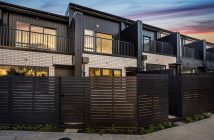Wellington City Council has made decisions on its proposed District Plan which, if approved by the Government, will greatly increase construction of new housing, it says

An Independent Hearings Panel (IHP) that presided over hearings in 2023 presented their recommendations to Council in February 2024. This is the latest stage in a marathon planning exercise to review and update the District Plan that has been in force since the beginning of this century.
The Wellington City Council Environment and Infrastructure | Kōrau Tūāpapa Committee rejected a number of the IHP recommendations around intensification, character, and heritage provision. Council also voted to adopt most of the technical recommendations by the IHP. The rejected recommendations will be referred to the Minister Chris Bishop for final decision.
Mayor Tory Whanau says it is of huge importance to the sustainable future of the city.
“Wellington City is growing, and our housing needs to grow with it. We are expecting 50 to 80 thousand more people over the coming 30 years. At a bare minimum, everyone in this city deserves a warm, safe, and dry place to call home.
“This District Plan represents a new direction for Wellington. We are going to build a modern city by enabling people to build where they want and need to, close to the central city where infrastructure, jobs and communities already exist. This is how we build an affordable, vibrant, and resilient city.
“As Mayor, I want to make sure that we are planning and building for the next generation. A generation who will bring their talent and ideas and add to our city’s rich history, culture and economy. To do that we need to make sure there are abundant and affordable places for them to live.
“Planning settings are only one part of the equation, but an important one, and I will continue to progress other priorities for our city including investment in infrastructure,” says Mayor Whanau.
Examples of decisions by the committee for Minister Bishop’s consideration include:
• Increasing walking catchments to allow housing intensification – from Tawa in the north to Newtown in the south.
• Intensification of the Kilbirnie suburban centre to be first subject to community consultation.
• Classifying the Johnsonville railway line as ‘rapid transit’ – enabling housing developments of up to six storeys close to rail stations along the line’s route.
• Extending the central city zone south on Adelaide Rd toward Newtown and making bigger (15-minute) walking catchments, providing for more housing units.
• Reducing the city’s ‘character areas’ from 206 hectares to 85 hectares.
• Removing the heritage listings for all the following buildings: Gordon Wilson Flats, the Miramar Gas Tank, Emeny House, Kahn House, Olympus Apartments, Wharenui Apartments, Robert Stout Building, Primitive Methodist Church, Johnsonville Masonic Hall, Star of the Sea Chapel.
Mayor Whanau says the votes are the culmination of an initiative that started in 2017 with community consultation.
“Many Wellingtonians told us during the consultation period that they wanted a city that was connected, inclusive, resilient, greener, and prosperous.
“I want to thank everyone who’s been involved in this process over the past few years – including thousands of submitters, the Independent Hearings Panel and our brilliant and patient planning staff. It’s been a big exercise but will have far-reaching, positive, outcomes for the city.”
The Proposed District Plan is a big shift from the city’s current planning rules. It also proposes:
• Greater recognition of mana whenua values and promotion of an active partnership in resource management processes.
• Increasing intensification and mixed-use spaces (blending residential, commercial, cultural, institutional, or entertainment spaces into one space within the existing urban area) to support Wellington’s goal of becoming carbon neutral by 2050.
• A risk-based approach for natural hazards, impacts of sea level rise, and climate change that balances intensification with adaptation.
• Implementing new controls and design guides to ensure high quality urban development.
Proposed District Plan parts that aren’t related to housing and other densification – such as open space zones, hospital and tertiary zones, and rural areas – are still being considered in hearings over the course of this year. The Independent Hearing Panel will report back to the Council with its recommendations on this remainder of the Plan in early 2025.
A comprehensive summary of the main District Plan decisions – and their impacts – can be found here.











